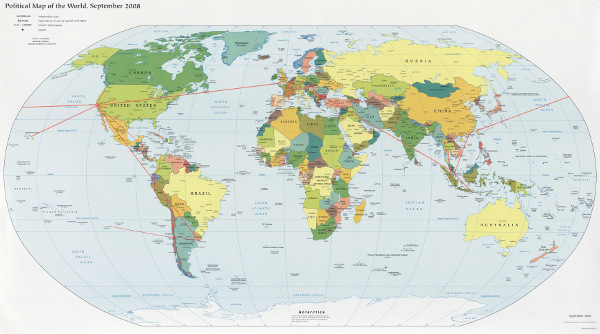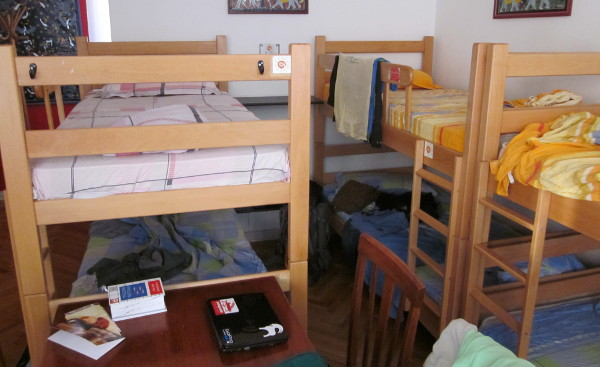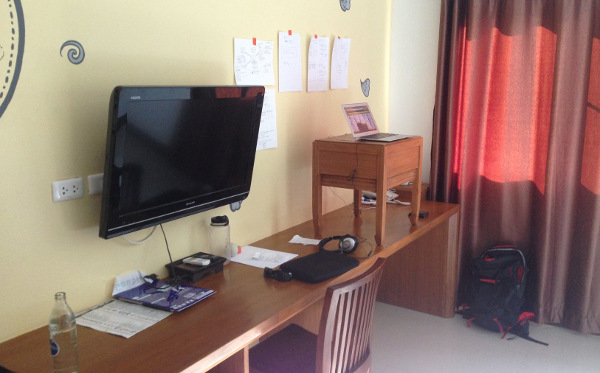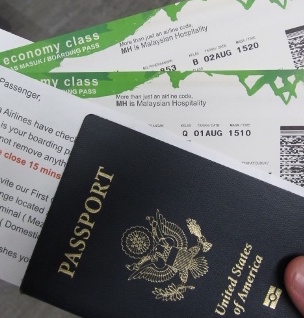The 6 Phases of Lifestyle Design
You quit your job. You buy a plane ticket. You leave to travel around the world. Then you figure out a way to make some money.

Most people go through a predictable series of steps on the road to a location-independent lifestyle. While the six phases listed here aren’t definitive or exactly linear, they sum up the lifestyle progression I’ve seen from dozens of travelers and veteran laptop nomads.
Here are the 6 phases of lifestyle-design as I currently see them:
Phase I: Going Postal (aka Binge Travel)

For those who restricted travel until later in life, there’s a tendency to overdo it.
When I left home in mid-2011 I flew straight to the Bay Islands off the coast of Honduras. Six months later I woke up in Uruguay–12 countries and several thousand kilometers later–after enduring endless bus rides, cheap hostels, and enough Flor de Cana to float a destroyer.
While it was one of the best adventures of my life, it wasn’t sustainable. Only the adrenaline rush of arriving in a new country could sustain that kind of pace, and by the time I booked my ticket out of Montevideo I never wanted to see another bus station, Lonely Planet, or hear Reggaeton again.
Binge travel is all most of us ever learn how to do, whether it’s 2 weeks or 6 months. You saved the money for travel and now you’re going to enjoy it, because who knows if you’ll ever get another chance.
Nearly everyone must go through this phase at least once, but most people also hit a wall somewhere between 4-6 months in. At that point, it’s time to do something else. Most people go home to repeat the work-save process, but those who don’t move into phase II.
Phase II: Figuring out How to Make Some Money
Each day on the road you see your finite freedom (cash) reserves dwindle, and one day you either decide to get serious and do something about it or make a plan for re-employment.
Since working for myself was always part of the plan I made sure to have a non-travel reserve of at least 6 months of cash in the bank at all times. Once the fun money was spent this was my business runway.
Ideally, you’d have 3 funds:
- Travel fund – Play money for your adventures. Expect to spend all of this.
- Business runway – Enough cash to get some income up and running.
- Emergency fund – For the worst-case scenario of returning home and finding a job.
The size of these can vary (funding 3 months to 1 year) depending on your particular situation and how well you can stick to a budget. At the very least it’s a good idea keep 3-6 months of spending money in the bank, which never gets touched unless all else fails.
So, how do I make some money if I don’t want to go home?
A lot of people opt for on-the-ground work, like working at the hostel bar, teaching English, or working at a dive shop. Some of these jobs can be great for a while. But most of them aren’t things you see yourself doing 5 years down the road.
This is what makes working on the internet such a great option: it’s the fastest route to a long-term location-independent lifestyle.
My scramble for viable income went down in Santa Cruz, where I proceeded to lock myself in a room and work 12 hour days until I had something to show for it. By the time I left I had a niche website that made $50 a month. Not exactly going to pay the bills, but it was a foothold: the exact amount needed to pay for 1/30th of my monthly travel budget.
The processes I followed was neither complicated nor technical, and it didn’t even hinge on my previous work experience: I read Pat Flynn’s guide to building niche websites and then I followed the exact steps listed there. That was it.
Whether or not you’ve worked online it can be difficult to know where to start, which is why it’s good to follow a known game plan. Test fast and cheaply, and iterate to infinity. Fortunately, the information you need is freely available, all you need is the time and dedication to learn, test, repeat.
It’s important to understand that building the foundation of a business is not going to be easy. It’s hard work. It’s ditch-digging. It can be fun and exciting but also incredibly frustrating.
Forget your 4-Hour WorkWeek fantasies for this part. Better to lock yourself in a room and get it done. I would expect this phase to take several months, but keep in mind you aren’t trying to replace your whole income, just test ideas and build the foundation for things to come.
Phase III: “Work” on your Laptop While you Travel the World

[Photo: Sunshine Hostel in Belgrade, Serbia]
Ah, living the dream. Sort of. Except that you never get anything done and have very little consistency in routine or environment.
The surprising advantage of long-term travel is that it’s so much cheaper than living in the USA. This means that with a very small but steady income, say $500 a month, you’ve buffered your travel budget expenses by 30-40%.
In early 2012 I left Santa Cruz and went to Hawaii, then spent 4 months in Europe. I worked some, but not as much as I thought I would. It’s easy to spend a great deal of time in this transition-phase, where you neither have a real-business nor a real desire to work full-time, but you have some kind of income.
This period was more about enjoying life than it was about work, and a lot of the people I’ve talked to said they had the most fun when they were making almost nothing and traveling around the world (side note: some people make a lot of money and do this indefintely. More power to them.)
The problem with this phase is that you’re either a) screwing around trying to game the internet to make money, which is not a long-term strategy (guilty) or b) you have found a potentially viable business idea and you’re letting it sit there–leaving large amounts of income on the table.
Phase IV: The Transition
One day I decided I’d been screwing around long enough. I stopped in Budapest, got an apartment, and started taking things seriously. And shortly after and realized that all the time spent on my laptop had paid off: I had a real business on my hands. Not an internet scam, not a job, but a business: something that could run itself and scale to levels much larger than I originally thought.
The next few months, which included moving to Bali, were nothing but hard work. This is where you ultimately build something or quit, and where 4-hour Workweek fantasies can trip you up again: at some point you start to ask yourself why the hell am I working so hard, I thought this was supposed to be fun/easy/fast?
The punchline was so well outlined in Work the System I’ll paraphrase it here:
Every business has a ‘construction’ phase that lasts for much longer than you expect. It’s hard work. It sucks. But one day you have to wake up and decide that you’re either building this Goddamn thing or you’re going to quit. Half-assed solutions aren’t going to work anymore.
Building a business this way is sort of like thinking you’re going for a walk in the park and realizing your at the bottom of Mt. Everest. It’s definitely a tunnel that you have to power through and it can literally be an all or nothing choice if you have clients or users: either get the product up and running or abandon it. But if you can get through this to a sustainable system–which of course includes hiring others, building technology, ironing out all the details–the benefits are well worth the time spent.
How long will this take? Whatever number you’re thinking right now multiply it by 2 or 3. At least. You are building a machine here, a factory line, a fully autonomous unit, and every possible fail-point has to be dealt with, let alone selling enough of the product to get to your target income.
It’s important to remember why we’re doing this: it’s not about $$$, it’s about long-term freedom, which requires a sustainable, guaranteed income. You have to climb over this mountain to get to the other side.
Phase V: The Lifestyle Business Designer

[Photo: Apartment in Chiang Mai, Thailand]
Things change here, and I think this is where the real fun starts.
This phase is only reached when you start to have stable & real income, which opens up all the options for lifestyle design because you stop sweating over every expense, and you no longer have a party’s over death-clock hanging over your head.
At this point I’ve stopped moving so much. I now book an apartment in a regional hotspot or base of operations and stay there for 1-3 months. This is enriching for a number of reasons (meeting people, learning about a place, absorbing more than I would by traveling through), but it also gives me the time to work and spin the gears on my routines.
One day you realize that you are living a sustainable lifestyle, and the outcome is going to depend on your ability to focus on what matters, limit inefficiency and unnecessary roadblocks, and get things done. You realize the the freedom you crave can be all-but-guaranteed by putting in the time, finding your “5 hours per day” to continue to build the system.
The hardest part of this phase for me has been finding balance. It’s easy to do nothing but work, but having the discipline to work, get exercise, have a social life, and stay healthy has been an ongoing work in progress. But the best part is: if you keep working at it you will find routines that will make sure you get it all in.
Want to wake up and work 6:30 to 12:30 then do whatever you want the rest of the day? Want to take 1 week off for every 3 you work? Want to live in a new city every 2 months? Want to work in modular units so you can surf when the waves come up? You can do that too. Best of all, you can live anywhere you want with an understanding of exactly what you’re doing and why you’re doing it.
You still don’t get to the 4-hour workweek yet, both because you don’t want to and because you haven’t built a complete system, but you can gradually take longer and longer breaks here.
Phase VI: The Business Owner (aka “The land-line and the fax machine”)
My friend Scott highlighted an Inc. Magazine article last year about the CEO of Paul Mitchell John Paul DeJoria. This guy has a home office with nothing more than a land-line and a fax machine inside.
Every work day this guy wakes up and walks into his “office” where he has a few check-in calls with his assistants. If he needs to sign anything it’s sent to his fax. Once the calls are over he’s done. Or he gets on his private jet to fly somewhere to meet the owners of a new Paul Mitchell salon.
The point is: this guy doesn’t have a computer in his office.
The ultimate dream is to build a fully-autonomous business–a machine that runs itself, employs a number of people, improves some aspect of the world, and produces revenue for everyone involved. A unit where every process and potential “fire” is handled by smart people who know their jobs.
This phase opens up most of what was promised by the 4-Hour Workweek: the ‘mini-retirement’, the indefinite travel binge, the building of multiple business, and so on.
This is the dream, but at this point it’s still a bit like riding into the sunset: I’ll keep riding toward it and see what happens.
Know what phase you’re in and enjoy it
If I’d understood the phases I would go through before starting down this road I would have enjoyed each part a lot more. Much of the time I was traveling I was worried about what the hell I was doing with my life, what I would do after I ran out of money, etc.
The most difficult hump has been the middle business building phase IV, where things are neither fully baked but have a life of their own. This is the golden handcuffs period where you can’t really walk away but you often feel like you want to.
But now I know that if I power through it I’m not really that far from the finish line.
A few resources for each phase:
- Phase I: The 4-Hour Workweek and Vagabonding, the Art of Long-term Travel
- Phase II & III: Listen to the entirety of the TropicalMBA podcast (formerly Lifestyle Business Podcast) and spend considerable amounts of time on how-to blog posts online.
- Phase IV & V: Work the System, Built to Sell, The Millionaire Fastlane, The Lean Startup, The Profit (TV Series)
If you’ve made it through any part of this I’d love to hear about your experiences.




